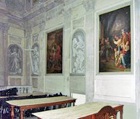Liborio Coccetti, who was born in Foligno, began his career in Umbria. He moved to Rome in ca. 1780, and became close to Pope Pius VI. His works were mainly in fresco and frequently for patrician palaces.
Foligno
Madonna and Child with SS Peter and Paul (1775)
The inscription on this altarpiece in the church of San Pietro Apostolo in Corvia, outside Foligno records that Liborio Coccetti painted it in the jubilee year of 1775. [Is it still there?]
St Mark in Glory (ca. 1775)
This fresco in the vault of San Marco, a church in Sant’ Eraclio outside Foligno, is attributed to Liborio Coccetti.
Giano dell’ Umbria, near Massa Martana
Scenes from the Life of St Felix (18th century)
These frescoes in the cloister of the Abbazia di San Felice are attributed to Liborio Coccetti.
Spoleto
Frescoes in Palazzo Benedetti di Montevecchio (ca. 1780)
The frescoes on the piano nobile of Palazzo Benedetti di Montevecchio, which are signed by Liborio Coccetti, include depictions of:
-
✴the Assumption of the Virgin, in the chapel; and
-
✴allegories of music, in the boudoir.
(They are illustrated in the site of Fondazione Federico Zeri).
Frescoes in San Domenico (18th century)
These frescoes in the Cappella Benedetti in San Domenico are attributed to Liborio Coccetti. They depict:
-
✴two scenes from the miracle of the the Sacro Chiodo (a nail that had been used in the Crucifixion of Christ and recovered by St Helena in the 4th century) in the lunettes:
-
•an angel guides the Blessed Gregory of Spoleto to recover the relic; and
-
•a bishop cures a blacksmith by touching him with the relic; and
-
✴scenes from the Passion of Christ in the cupola:
-
•Christ nailed to the cross;
-
•the Crucifixion;
-
•the Pietà; and
-
•St Helena, the mother of the Emperor Constantine, throwing the sacred nail into the Adriatic to still a terrible storm that threatened to wreck the ship on which she returned to Italy from Jerusalem.
Altarpieces in Cappella del Sacramento, Duomo
The altarpieces in this chapel, which form a cycle on themes related to the Eucharist, include:
-
✴on the left, starting from the door:

-
•Elijah and the angel (1791), signed by Pietro Labruzzi and dated by inscription; and
-
•the last supper (1784) by Liborio Coccetti; and
-
✴on the right, starting from the door:

-
•the fall of the idol, Dagon (1784), signed by Liborio Coccetti; and
-
•the fall of manna to feed the Israelites (1791) by Pietro Labruzzi.
Palazzo Morelli (1773-5)
[Frescoes here are signed and dated - is this Villa Morelli, outside Spoleto?] .
Terni
Trinity in Glory (1782)
This fresco by Liborio Coccetti in the semi-dome of the apse of the Duomo has been heavily repainted.
Frescoes in Palazzo Gazzoli (18th century)
The frescoes of mythological scenes on the ceilings of two rooms of the piano nobile of Palazzo Gazzoli (the Sala di Apollo and the Sala dell' Aurora) are attributed to Liborio Coccetti.



